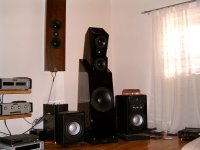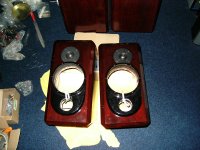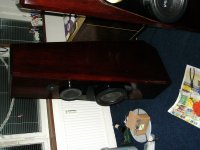some photos
all you wrote is true... my approach... cheers and keep it "secret" ...
Attachments
I agree with her 100%. Not only do I want no trouble but she is right.If you'd like to argue with my Italian wife, I'll put her on the computer. God help us all.
One of the great philosophical questions of all time. If a man yells into the woods but there is no woman listening, is he still wrong?Thank you Fernando, they're always right. Italian or otherwise.
Prior to this speaker, my wife often sat 'off axis'. Now she pushes me out of the sweet spot.
I thought it might have been nice to have an audiophile wife
I thought it might have been nice to have an audiophile wife
......But then most men have a deaf ear to the nonsense most women go on about.
C.M
One of the great philosophical questions of all time. If a man yells into the woods but there is no woman listening, is he still wrong?
LOL.
Nice one.
One of the great philosophical questions of all time. If a man yells into the woods but there is no woman listening, is he still wrong?
Of course he is, he should be locked up.
C.M
Why not recess the tweeter into a shallow waveguide and lose the disadvantages?
Exactly. In my systems the woofer and tweeter tend to be perfectly time aligned with the crossover in place so no baffle step needed at all and perfect polar response to boot!
Thank you Fernando, they're always right. Italian or otherwise.
See that actually is a big problem. One time when I was doing development work on a crossover this guys wife kept complaining about this and that. I did not see (or hear) what she was complaining about so one time I made no changes and came back and claimed exactly the change that she wanted. She loved it claiming"yea, now that's better!" I quit listening to her. I should say that she was not the exception, most people would have fallen for the same test. Just one reason why I don't design by listening.
Exactly. In my systems the woofer and tweeter tend to be perfectly time aligned with the crossover in place so no baffle step needed at all and perfect polar response to boot!
It looks really impressive, is it as impressive in the vertical plane?
And +25,+25degrees, and +45,+45dgr?
Which compensations do you see as the most important ones in order to achieve a percieved flat response from your loudspeakers?
Yes, of course the vertical is not as well controlled. There are two holes in the vertical plane as there must be with non-concentric drivers. But if the floor and ceiling bounce are dealt with and one does not sit too close to the speakers these holes will not enter into the picture.
By +- 25 and +- 45 dgr, do you mean horizontal or vertical? Vertical I don;t know exactly as I don;t usually measure the vertical. The holes are at approximately +- 15 dgr.
I also don't know what you mean by "compensations". Compensation for what? I design for a smooth DI, as large as practicable, along the listening axis, which I do not recommend be 0 degrees, I recommend a toe-in of about 20 dgr. I think that a slight HF roll-off of a few dB sound more natural with CD speakers.
By +- 25 and +- 45 dgr, do you mean horizontal or vertical? Vertical I don;t know exactly as I don;t usually measure the vertical. The holes are at approximately +- 15 dgr.
I also don't know what you mean by "compensations". Compensation for what? I design for a smooth DI, as large as practicable, along the listening axis, which I do not recommend be 0 degrees, I recommend a toe-in of about 20 dgr. I think that a slight HF roll-off of a few dB sound more natural with CD speakers.
Exactly. In my systems the woofer and tweeter tend to be perfectly time aligned with the crossover in place so no baffle step needed at all and perfect polar response to boot!
GedLee, I like that Idea. I will incorporate that in the future. Am I correct to assume I may need to pad the tweeter more to compensate for the better coupling between driver and air?
If you mean using a waveguide, you will find that it is a much more complex situation than dealing with direct radiators. A direct radiator has a theoretical flat on-axis response because it gets narrower and narrower as the freq goes up. A good waveguide has a constant coverage angle and as such its axial response is falling as the freq goes up. This means that you will likely have to pad down the tweeter at its low end, but not at the high end. Passively this can lead to complicated crossovers. With DSP its not too hard.
The last speaker that I built was a 3way with a sloped baffle. The angle and driver placement was such as to minimize the differences in their acoustic centers at a specific listening distance/height. I was able to get pretty close, but it was optimized for that one reasonable listening location. It turned out to be a vert coherent speaker that sounds a lot like a single driver full range without the shortcomings. Just needed to build a spreadsheet to do the trig. Still my favorite.
Paul
I agree. There are many good sounding tweeters that have a rising high end response. Placed on a tilted baffle, they "flatten out" on axis, provide more "air" off axis, sound better than "flat baffle" speakers when you're standing up, and inherently time align "on axis". Also, diffraction signature "on axis" is closer to the power average, especially when toed in, so there's less trading off between on axis response and off axis response. Result is a speaker less sensitive to the room or to the seating location, that still sounds good standing up and doesn't need a particularly complicated crossover.
15degrees for the holes is about where i also try to have them.
I mean 25 dgr horizontal 25 dgr vertical.
With compensations i mean i can see a tiny bump at 1.5 khz and a "dent" at 3 khz at 20dgrs.in your ns15. Two places where these kind of features usually tends to do good things to the percieved sound.
Thats why I wonder if they are intentional.
I mean 25 dgr horizontal 25 dgr vertical.
With compensations i mean i can see a tiny bump at 1.5 khz and a "dent" at 3 khz at 20dgrs.in your ns15. Two places where these kind of features usually tends to do good things to the percieved sound.
Thats why I wonder if they are intentional.
"Time-aligned" seems to be fraught with ambiguity. What is Time-Alignment
15degrees for the holes is about where i also try to have them.
I mean 25 dgr horizontal 25 dgr vertical.
With compensations i mean i can see a tiny bump at 1.5 khz and a "dent" at 3 khz at 20dgrs.in your ns15. Two places where these kind of features usually tends to do good things to the percieved sound.
Thats why I wonder if they are intentional.
The intent is a smooth response from 700 - 10 kHz, from +-40 degrees. Maximum attention is paid to the listening axis of 20 degrees. This is quite difficult to achieve even for DSP since DSP can only boost or cut all angles simultaneously, so "dents" and localized hills, are not correctable. One has to balance all angles with what the DSP does. Only the acoustics can affect non-uniform polars.
Hi Earl,
Thanks so much for your input. I'm curious when you say perfectly time aligned. Do you mean the step response has only one left edge, or that the tweeter and mid blend perfectly?
Both.
- Status
- This old topic is closed. If you want to reopen this topic, contact a moderator using the "Report Post" button.
- Home
- Loudspeakers
- Multi-Way
- Stepped Baffles - Baffling!


